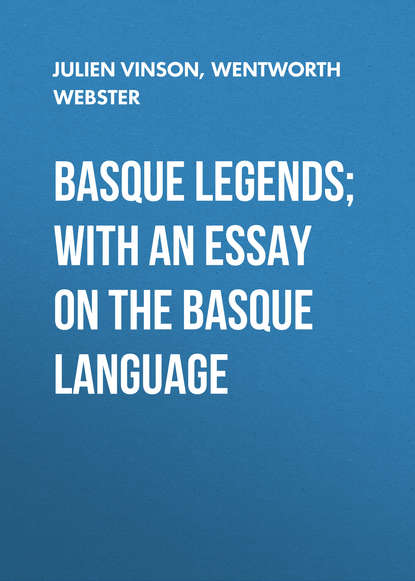По всем вопросам обращайтесь на: info@litportal.ru
(©) 2003-2024.
✖
Basque Legends; With an Essay on the Basque Language
Автор
Год написания книги
2018
Настройки чтения
Размер шрифта
Высота строк
Поля
67
Compare this with the scene in Apuleius, “De Asino Aureo;” and, for a somewhat similar “fairy ointment,” see Hunt’s “Popular Romances of the West of England,” pp. 110–113.
68
The blunder is confounding “dessus,” over, and “dessous,” under. This shows that the tale is originally French, or, at least, the witch’s part of it; for this punning mistake could not be made in Basque. The two words are not in the least similar in sound. “Gaiñetik” and “azpetik” are the words here used.
69
Witches still appear in the shape of cats, but generally black ones. About two years ago we were told of a man who, at midnight, chopped off the ear of a black cat, who was thus bewitching his cattle, and lo! in the morning it was a woman’s ear, with an earring still in it. He deposited it in the Mairie, and we might see it there; but we did not go to look, as it was some distance off.
70
Literally, “red misery.” In Basque the most intense wretchedness of any kind is always called “red.”
71
There are several superstitions connected with cross-roads in the Pays Basque. When a person dies, the bedding or mattress is sometimes burnt at the nearest cross-roads, and every passer-by says a “Paternoster” for the benefit of the deceased. This custom is becoming extinct, but is still observed in old families.
72
This is, of course, only a mispronunciation of “Dominus tecum”—“The Lord be with you.” Compare the opposite effect of “God save us,” in Croker’s tale of “Master and Man,” pp. 96, 97.
73
See notes to “Juan Dekos,” p. 146.
74
I think this word occurs in some “Chanson de Gestes,” and in the Basque “Pastorales,” as a Mahommedan devil. If not, it is probably our own “Duke of Marlborough” thus transformed. Cf. the song, ”Malbrouk s’en va en guerre.”
75
This is again, “red, angry.”
76
Cf. Campbell, “The Tale of Connal,” Vol. I., p. 142.
77
This looks uncommonly like “Ho, you!” but it is given by Salaberry as a Basque cry, “Appel par un cri fort, par la voix élevée.” “Play,” as an exclamation to begin at games of ball, has no meaning in Basque, and is believed to come from the English. We have borrowed “Jingo,” “by Jingo,” from “Jinkoa,” “the deity.”
78
In Campbell’s first tale, “The Young King of Easaidh Ruadh, the hero is assisted by a dog, a falcon, and an otter. Cf. the notes in the translation of this tale in Brueyre’s “Contes de la Grande Bretagne;” cf. also, “The Sea-Maiden,” pp. 73 and 94, for a still closer resemblance.
79
Cf. “Tabakiera,” p. 94, and “Old Deccan Days,” pp. 83–91. It is curious to hear of the Red Sea from narrators so far apart, on opposite sides, as the Lingaets of the Deccan and the Basques, neither of whom, probably, had the most distant idea of its geographical position; certainly our Basque narrators had not.
80
In Campbell’s “Sea-Maiden,” the hero has only to think of the animals, and they are at his side; but he is not transformed into them.
81
Campbell refers to “The Giant who had no Heart in his Body,” “Norse Tales,” 1859. See his references, and those in the “Contes Populaires de la Grande Bretagne,” cited above. M. d’Abbadie has also communicated to us the outlines of a wild Tartaro story, told in Basque, in which the hero “fights with a body without a soul.”
82
Cf. Campbell’s “Tales,” before quoted, and “Old Deccan Days” (“Punchkin”), pp. 14, 15, for the whole of this incident.
83
Malbrouk seems now to assume the character of “Hermes, the clever thief.” If we mistake not, this cow appears also in Indian mythology.
84
For the whole of this tale compare Campbell’s “Sea-Maiden,” Vol. I., p. 71. The sea-maiden takes the place of the fish. Besides the three sons, the three foals, and the three puppies, three trees grow behind the house, and serve as a sign like the well boiling. Bladé’s “Les Deux Jumeaux,” in his “Contes Agenais,” is identical with this; cf. also Köhler’s notes, p. 148.
85
Much more is made of the sword in the Gaelic tales. In them it is always a magic or a mystic weapon.
86
This episode of the fight with the seven-headed beast is introduced in the same way in the Gaelic—“The Sea-Maiden,” pp. 76, 77. Cf. also “Rouge Etin,” in Brueyre.
87
In the Gaelic the charcoal-burner is a general.
88
This takes place not on the wedding night, but some time after in the “Sea-Maiden,” p. 82. The wife at prayers and the husband standing by indifferent is but too true a picture, we fear.
89
The “Sea-Maiden,” p. 82—“Go not, go not,” said she, “there never went man to this castle that returned.” See below.
90
Basque, “as must needs be.”
91
We were also told, in Basque, “The Powerful Lantern,” which was the story of Aladdin’s lamp, with only one incident omitted. The present is much more like the Gaelic, but there (Campbell, Vol. II., 297–9) it is a lady who gives the snuff-box, which says, “Eege gu djeege,” on being opened. Campbell’s note is:—“The explanation of these sounds was, that it was ‘as if they were asking.’ The sounds mean nothing, that I know of, in any language.” “Que quieres?” is pure Spanish—“What dost thou want?”
Compare this with the scene in Apuleius, “De Asino Aureo;” and, for a somewhat similar “fairy ointment,” see Hunt’s “Popular Romances of the West of England,” pp. 110–113.
68
The blunder is confounding “dessus,” over, and “dessous,” under. This shows that the tale is originally French, or, at least, the witch’s part of it; for this punning mistake could not be made in Basque. The two words are not in the least similar in sound. “Gaiñetik” and “azpetik” are the words here used.
69
Witches still appear in the shape of cats, but generally black ones. About two years ago we were told of a man who, at midnight, chopped off the ear of a black cat, who was thus bewitching his cattle, and lo! in the morning it was a woman’s ear, with an earring still in it. He deposited it in the Mairie, and we might see it there; but we did not go to look, as it was some distance off.
70
Literally, “red misery.” In Basque the most intense wretchedness of any kind is always called “red.”
71
There are several superstitions connected with cross-roads in the Pays Basque. When a person dies, the bedding or mattress is sometimes burnt at the nearest cross-roads, and every passer-by says a “Paternoster” for the benefit of the deceased. This custom is becoming extinct, but is still observed in old families.
72
This is, of course, only a mispronunciation of “Dominus tecum”—“The Lord be with you.” Compare the opposite effect of “God save us,” in Croker’s tale of “Master and Man,” pp. 96, 97.
73
See notes to “Juan Dekos,” p. 146.
74
I think this word occurs in some “Chanson de Gestes,” and in the Basque “Pastorales,” as a Mahommedan devil. If not, it is probably our own “Duke of Marlborough” thus transformed. Cf. the song, ”Malbrouk s’en va en guerre.”
75
This is again, “red, angry.”
76
Cf. Campbell, “The Tale of Connal,” Vol. I., p. 142.
77
This looks uncommonly like “Ho, you!” but it is given by Salaberry as a Basque cry, “Appel par un cri fort, par la voix élevée.” “Play,” as an exclamation to begin at games of ball, has no meaning in Basque, and is believed to come from the English. We have borrowed “Jingo,” “by Jingo,” from “Jinkoa,” “the deity.”
78
In Campbell’s first tale, “The Young King of Easaidh Ruadh, the hero is assisted by a dog, a falcon, and an otter. Cf. the notes in the translation of this tale in Brueyre’s “Contes de la Grande Bretagne;” cf. also, “The Sea-Maiden,” pp. 73 and 94, for a still closer resemblance.
79
Cf. “Tabakiera,” p. 94, and “Old Deccan Days,” pp. 83–91. It is curious to hear of the Red Sea from narrators so far apart, on opposite sides, as the Lingaets of the Deccan and the Basques, neither of whom, probably, had the most distant idea of its geographical position; certainly our Basque narrators had not.
80
In Campbell’s “Sea-Maiden,” the hero has only to think of the animals, and they are at his side; but he is not transformed into them.
81
Campbell refers to “The Giant who had no Heart in his Body,” “Norse Tales,” 1859. See his references, and those in the “Contes Populaires de la Grande Bretagne,” cited above. M. d’Abbadie has also communicated to us the outlines of a wild Tartaro story, told in Basque, in which the hero “fights with a body without a soul.”
82
Cf. Campbell’s “Tales,” before quoted, and “Old Deccan Days” (“Punchkin”), pp. 14, 15, for the whole of this incident.
83
Malbrouk seems now to assume the character of “Hermes, the clever thief.” If we mistake not, this cow appears also in Indian mythology.
84
For the whole of this tale compare Campbell’s “Sea-Maiden,” Vol. I., p. 71. The sea-maiden takes the place of the fish. Besides the three sons, the three foals, and the three puppies, three trees grow behind the house, and serve as a sign like the well boiling. Bladé’s “Les Deux Jumeaux,” in his “Contes Agenais,” is identical with this; cf. also Köhler’s notes, p. 148.
85
Much more is made of the sword in the Gaelic tales. In them it is always a magic or a mystic weapon.
86
This episode of the fight with the seven-headed beast is introduced in the same way in the Gaelic—“The Sea-Maiden,” pp. 76, 77. Cf. also “Rouge Etin,” in Brueyre.
87
In the Gaelic the charcoal-burner is a general.
88
This takes place not on the wedding night, but some time after in the “Sea-Maiden,” p. 82. The wife at prayers and the husband standing by indifferent is but too true a picture, we fear.
89
The “Sea-Maiden,” p. 82—“Go not, go not,” said she, “there never went man to this castle that returned.” See below.
90
Basque, “as must needs be.”
91
We were also told, in Basque, “The Powerful Lantern,” which was the story of Aladdin’s lamp, with only one incident omitted. The present is much more like the Gaelic, but there (Campbell, Vol. II., 297–9) it is a lady who gives the snuff-box, which says, “Eege gu djeege,” on being opened. Campbell’s note is:—“The explanation of these sounds was, that it was ‘as if they were asking.’ The sounds mean nothing, that I know of, in any language.” “Que quieres?” is pure Spanish—“What dost thou want?”
Другие электронные книги автора Wentworth Webster
Spain




 0
0






